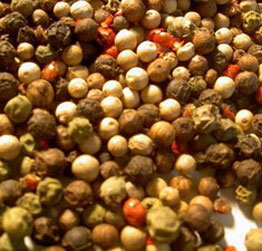
 Despite being affected by unfavorable weather, our country's harvested pepper output in 2010 decreased significantly. While the world pepper market is lower than demand, the price of pepper increased steadily, promising Vietnam's pepper exports for another positive year.
Despite being affected by unfavorable weather, our country's harvested pepper output in 2010 decreased significantly. While the world pepper market is lower than demand, the price of pepper increased steadily, promising Vietnam's pepper exports for another positive year.
According to the Ministry of Agriculture and Rural Development, in March 2010, our country exported 9 thousand tons of pepper, worth US $ 23 million. The export of pepper in the first quarter of 2010 was 23 thousand tons, with a turnover of nearly US $ 66 million, down 14.55% in volume over the same period last year, but increasing by 1.54% in turnover. The average export price from the beginning of the year to date reached 3,111 USD / ton, up 22.1% over the same period last year.
The three largest consumer markets of Vietnam experienced strong growth: the German market tripled; India doubled; The US increased 39.82%. Vietnam's pepper export in 2009 is estimated at 128,000 tons, turnover is 328 million USD, reaching a record ever.
Since 2001, Vietnam has always maintained its leading position in the world in pepper production and export. Vietnam's pepper harvest has gradually stabilized, with little increase or decrease in output in recent years: 91,000 tons in 2007; in 2008 reached 98,500 tons; in 2009 reached 105,600 tons.
In the South Central Coast, at the end of September and early November 2009, due to two continuous typhoons, thousands of hectares of pepper were flooded and died, so the pepper output of the provinces in this region decreased. significant reduction in harvest in early 2010.
The World Pepper Commission (IPC) forecasts that Vietnam's pepper output will be about 90,000 tons in 2010. However, the Vietnam Pepper Association is still optimistic given the forecast of Vietnam's pepper supply. This year will reach more than 100,000 tons.
The impact of natural disasters and extreme weather not only reduces yields, but also slows down the harvest time. Normally, the annual pepper harvest in our country starts from January, but this year it is not until mid-February that new pepper is available for sale to the market. This is the reason that despite the increase in selling price and demand, the export of pepper in the first quarter decreased by 14.55% in volume.
Although quite stable in terms of area and output, pepper experts from the Ministry of Agriculture and Rural Development still believe that Vietnam's pepper industry still has some problems that need to be overcome. That is, pepper production is still in small scale, not yet having a scale, finding and developing consumer markets still lack initiative, thus leading to unstable prices.
Vietnam has only built Chu Se pepper brand but has not built pepper brand of other localities, so only Chu Se pepper can sell at high prices, and pepper in other localities is always be purchased at a lower price.
In order for the pepper industry to develop sustainably and bring into full play its great potential, the Ministry has set a goal of keeping the pepper area stable at 50,000 ha and an output of 100,000 tons / year. At the same time, constantly improving the quality of pepper, localities must guide growers to follow the process of high quality standards to create clean, safe products, making the value of goods increasingly increase.
The role of market information in the pepper industry has also been increasingly focused, so that farmers and businesses can be proactive in production and business, enhance trade promotion, trade in international cooperation, capture the performance. variables of the market to make forecasts and recommendations to farmers and businesses.
According to the IMF, the world economy in 2010 will gradually escape from the crisis and the growth rate may reach 2.5-3%. This will help brighten the picture of the world's pepper imports. From a supply and demand perspective, the global pepper market is likely to face a shortage of supply. Therefore, pepper prices in 2010 will recover at a faster rate than in 2009 and will remain high. The recovery of pepper export prices inevitably has an impact on pepper prices in Vietnam's domestic market.
On the other hand, the high Indian pepper price also makes the US and European countries look to pepper from countries with cheaper export prices, including Vietnam, which will also help Vietnam pepper prices to recover quickly. than. After months of price reduction at the end of 2009, domestic pepper prices have increased rapidly again, currently ranging from VND 40,000 to VND49,000 / kg, nearly double that of the beginning of 2009.
Source link
